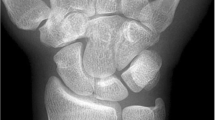Abstract
Purpose
The lunate is classified into two types, one with a single distal facet and the other with two distal facets. The effect of lunate type on the incidence of wrist disease and trauma remains unclear. The purpose of this study is to evaluate a potential association between lunate morphology and wrist disorders.
Methods
We retrospectively reviewed the cases of 637 patients who had undergone wrist arthroscopy for wrist disorders. Patient charts and arthroscopic video images were reviewed retrospectively. We defined lunate type based on the Viegas classifications, according to its distal facet from a midcarpal arthroscopic image. Patient wrist disorders were divided into four groups: fractures and dislocations, Kienböck’s disease, ulnar wrist pain, and degenerative disease.
Results
A Viegas type 1 lunate was observed in 349 wrists and a type 2 lunate in 288 wrists. Incidence of the type 2 lunate was different between the groups and was significantly lower for the Kienböck’s disease and ulnar wrist pain groups than for the trauma and degenerative groups.
Conclusions
The present study revealed a variable incidence of lunate type in wrist disorders. The proportion of type 2 lunates was lower in Kienböck’s disease and ulnar wrist pain.

Similar content being viewed by others
References
Arai T (1993) Roentgenographical and anatomical study of the midcarpal joint–morphology and degenerative change of ulnar side. Nippon Seikeigeka Gakkai Zasshi. 67:1114–1121 (Japanese)
Dautel G, Merle M (1997) Chondral lesions of the midcarpal joint. Arthroscopy 13:97–102
Dharap AS, Al-Hashimi H, Kassab S, Abu-Hijleh MF (2006) The hamate facet of the lunate: a radiographic study in an Arab population from Bahrain. Surg Radiol Anat 28:185–188
Dyankova S (2007) Anthropometric characteristics of wrists joint surfaces depending on lunate types. Surg Radiol Anat 29(7):551–559
Dyankova S, Marinov G (2007) Comments about “The hamate facet of the lunate: a radiographic study in an Arab population from Bahrain”. Surg Radiol Anat 2:181 (author reply 183)
Galley I, Bain GI, McLean JM (2007) Influence of lunate type on scaphoid kinematics. J Hand Surg 32A:842–847
Holveck A, Wolfram-Gabel R, Dosch JC et al (2011) Scaphotrapezial ligament: normal arthro-CT and arthro-MRI appearance with anatomical and clinical correlation. Surg Radiol Anat 33(6):473–480
Mohammed Ali MH (2009) A normal data-base of posteroanterior radiographic measurements of the wrist in healthy Egyptians. Surg Radiol Anat 31(9):665–674
Nakamura K, Beppu M, Patterson RM, Hanson CA, Hume PJ, Viegas SF (2000) Motion analysis in two dimensions of radial-ulnar deviation of type I versus type II lunates. J Hand Surg 25A:877–888
Nakamura K, Patterson RM, Moritomo H, Viegas SF (2001) Type I versus type II lunates: ligament anatomy and presence of arthrosis. J Hand Surg Am 26:428–436
Pfirrmann CW, Theumann NH, Chung CB, Trudell DJ, Resnick D (2002) The hamatolunate facet: characterization and association with cartilage lesions–magnetic resonance arthrography and anatomic correlation in cadaveric wrists. Skeletal Radiol 31:451–456
Sagerman SD, Hauck RM, Palmer AK (1995) Lunate morphology: can it be predicted with routine X-ray films? J Hand Surg Am 20:38–41
Schuurman AH, Maas M, Dijkstra PF, Kauer JM (2001) Ulnar variance and the shape of the lunate bone. A radiological investigation. Acta Orthop Belg 67:464–467
Viegas SF, Wagner K, Patterson R, Peterson P (1990) Medial (hamate) facet of the lunate J. Hand Surg 15A:564–571
Viegas SF (1990) The lunatohamate articulation of the midcarpal joint. Arthroscopy 6:5–10
Viegas SF, Patterson RM, Hokanson JA, Davis J (1993) Wrist anatomy: incidence, distribution, and correlation of anatomic variations, tears, and arthrosis. J Hand Surg Am 18:463–475
Acknowledgments
Statistical analysis was performed by Prof. T. Imaeda of the Department of Food and Nutritional Environment, Kinjo Gakuin University School of Human Life and Environment, Nagoya, Japan.
Conflict of interest
The authors had no conflict of interest.
Author information
Authors and Affiliations
Corresponding author
Rights and permissions
About this article
Cite this article
Tatebe, M., Shinohara, T., Okui, N. et al. Arthroscopic lunate morphology and wrist disorders. Surg Radiol Anat 35, 79–83 (2013). https://doi.org/10.1007/s00276-012-0991-2
Received:
Accepted:
Published:
Issue Date:
DOI: https://doi.org/10.1007/s00276-012-0991-2




